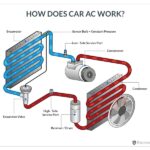When your car’s air conditioning starts blowing warm air, a common first step for many DIYers is to reach for an A/c Recharge Pressure Chart. These charts seem like a straightforward way to diagnose and fix the problem by indicating the correct refrigerant pressure ranges for your system. However, relying solely on these charts can be misleading, especially in modern vehicles with more complex and sensitive AC systems. While pressure readings can offer some insight, they often fail to provide the complete picture needed for an accurate and effective AC recharge. This is where the concept of charging by weight becomes crucial.
The Pitfalls of Relying Solely on A/C Recharge Pressure Charts
A/C recharge pressure charts are essentially simplified guides. They provide ideal pressure ranges based on ambient temperature, suggesting what the high and low side pressures should be during an AC system test. However, these charts operate under ideal conditions and fail to account for the numerous variables that can influence pressure readings in a real-world scenario. Factors such as humidity, specific vehicle system design, and even the efficiency of your compressor can significantly alter pressure readings.
Modern vehicle AC systems are also far more intricate than systems of the past. They often incorporate sophisticated controls and sensors that manage refrigerant flow and compressor operation based on a multitude of inputs. Because of this complexity, pressure readings alone can be deceptive. What appears to be a correct pressure reading according to a chart might still represent an improperly charged system due to underlying issues or simply the system’s dynamic operation. Relying solely on pressure can lead to both undercharging and overcharging, neither of which is beneficial for your AC system’s performance or longevity.
Why Charging by Weight is the More Accurate Method
Vehicle manufacturers specify the precise amount of refrigerant, by weight, that each AC system should hold. This specification is determined through rigorous testing and engineering to ensure optimal performance and system health. Charging by weight means you are introducing the exact amount of refrigerant the system is designed for, eliminating the guesswork and inaccuracies associated with pressure charts.
Charging by weight offers several key advantages:
- Precision: It ensures the correct refrigerant charge regardless of external temperature or humidity.
- Reliability: It is a consistent and repeatable method, minimizing the chances of errors.
- System Health: Correct charging prevents both undercharging, which can lead to poor cooling and compressor damage, and overcharging, which can cause excessive pressure and potential system leaks or failures.
By adhering to the manufacturer’s specified refrigerant weight, you bypass the limitations of pressure charts and provide your AC system with the precise charge it needs to operate efficiently and reliably. While pressure readings can be a supplementary diagnostic tool, they should not be the primary method for determining the correct refrigerant charge.
Real-World Example: System Complexity and Pressure Fluctuations
Consider a scenario where a vehicle’s AC system seems to have fluctuating performance, cooling adequately at times but struggling in stop-and-go traffic. Initially, one might check the pressure readings against a chart and attempt to adjust the refrigerant based on those values. However, as illustrated in experiences with some newer trucks, the issue might not be directly related to the refrigerant level indicated by pressure alone.
For instance, in certain vehicles, the engine cooling fan engagement, controlled by the vehicle’s computer, plays a critical role in maintaining optimal AC system pressures. If the fan engagement is not properly calibrated or delayed, the high side pressure can climb excessively, even if the refrigerant charge is within the range suggested by a pressure chart. This pressure fluctuation can lead to inconsistent cooling performance, despite seemingly “correct” pressure readings at certain moments. This example underscores that system pressures are dynamic and influenced by numerous factors beyond just the amount of refrigerant.
Conclusion: Prioritize Weight for Optimal A/C Recharge
While a/c recharge pressure charts can offer a basic reference point, they are not a substitute for accurate refrigerant charging, especially in today’s sophisticated automotive AC systems. For a truly effective and reliable AC service, prioritize charging by weight according to the vehicle manufacturer’s specifications. This method ensures your system receives the precise refrigerant charge it needs, leading to optimal cooling performance, system longevity, and avoiding the misleading interpretations that can arise from relying solely on pressure charts. Understanding the nuances of your vehicle’s AC system and adopting weight-based charging is the key to keeping your cool on the road.
